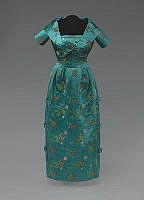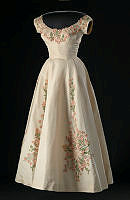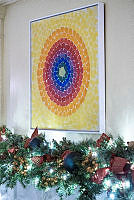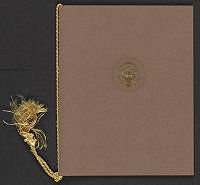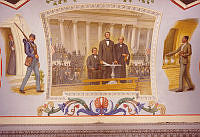Rubenstein Center Scholarship
Prominent African-American Women and the White House
Sojourner Truth to Michelle Obama
This article is part of the Slavery in the President’s Neighborhood initiative. Explore the Timeline
Although Michelle Obama was the first African-American first lady of the United States, African Americans have been integrally involved in the history of the White House from its initial construction in 1792.1 Mrs. Obama’s speech during the 2016 Democratic National Convention reminded the nation of a commonly unacknowledged aspect of our shared history, embedded within the structure of the White House itself: “I wake up every morning in a house that was built by slaves.”2 Reflecting on this reality, Mrs. Obama referenced America’s past to acknowledge “the story of generations of people who felt the lash of bondage, the shame of servitude, the sting of segregation, but who kept on striving and hoping and doing what needed to be done.”3 The perseverance and persistence of such individuals helped create the possibility for an African-American man, Barack Obama, to be elected president of the United States. As first lady, Michelle Obama used her platform in order to influence social activism; her efforts were largely inspired by a lineage of African-American women before her.
Notable African-American women activists such as Sojourner Truth, Elizabeth Keckly (also spelled Keckley), Rosa Parks, and Maya Angelou, have affected the national trajectory, pushing the country toward greater collective progress.4 Their various impacts on abolition and women’s suffrage, contraband relief, civil rights, and the nature of American literature, respectively, have brought several of these figures to the White House.

This painting of President Abraham Lincoln was created by R. D. Bayley. The painting depicts Lincoln showing abolitionist Sojourner Truth a bible gifted to him by African-Americans from Baltimore, Maryland.
Library of CongressSojourner Truth (1797-1883) was born into slavery as Isabella Baumfree in Ulster County, New York.5 She was bought and sold four times and “subjected to harsh physical labor and violent punishments.”6 Her freedom was purchased by an abolitionist family, the Van Wagenens, in 1827.7 As the result of her status as an enslaved person, Truth was denied access to education. She, nevertheless, came to be known as an impressive speaker, preacher, activist, and abolitionist.8 In 1843, she received a calling from God to travel the nation (sojourn) preaching the Bible.9 Truth stands as the only African-American woman to have achieved national recognition on a lecture platform prior to the Civil War.10 She was “one of the few African American women to participate in both the abolition of slavery and women's rights movements.”11
In 1864, when Sojourner Truth was about sixty-seven years old, she made plans to visit President Abraham Lincoln.12 President Lincoln was a pivotal figure in her eyes as he had recently issued the Emancipation Proclamation on January 1, 1863. She sought commendation from the president for her efforts to aid the thousands of freedmen living in deplorable conditions in Freedman’s Village, a contraband camp, located in Arlington Heights, Virginia.13 Truth traveled from her home in Battle Creek, Michigan to Washington, D.C.14 Upon her arrival, she became aggravated when she “was unable on her own to secure an appointment to visit Lincoln.”15 Sojourner then asked “Lucy Colman—a white, Massachusetts-born schoolteacher who had become an anti-slavery lecturer”—to arrange a meeting on her behalf.16 Colman contacted Elizabeth Keckly— who was an African-American dressmaker working for First Lady Mary Todd Lincoln—as an intermediary, and several weeks later succeeded in requesting an audience with the president.17 On October 29, 1864, Truth and Colman went to the White House.18 Click here to learn more about the household of President Abraham Lincoln.

One of the most famous African-Americans to visit the White House during Lincoln’s term in office was Sojourner Truth.
Library of CongressExpressing her appreciation for Mr. Lincoln’s emancipation efforts, Sojourner Truth told President Lincoln, “I thank God that you were the instrument selected by Him and the people to do it.”19 In a letter dated November 17, 1864, Sojourner Truth recalls that during her visit, President Lincoln showed her “the splendid Bible presented to him by the colored people” of Baltimore. After looking it over she said to him: ‘This is beautiful; and to think that the coloured people have given this to the head of the Government, and to think that Government once sanctioned laws that would not permit its people to learn enough to be able to read that book. And for what? Let them answer who can.’”20 Treated with immense kindness and respect by President Lincoln, “I thanked God from the bottom of my heart that I always advocated his cause, and done it openly and boldly...".21 A month after their meeting, in which Sojourner Truth also called the president’s attention to the conditions of the contraband camps, she took up residence in Freedman’s Village where she was appointed counselor to the freed people living there.22
As a notable orator, Sojourner Truth served as an inspiration for Michelle Obama, who is also recognized for her speaking ability.23 According to authors Suzanne Pullon and Roseann Mandziuk, throughout Truth’s “rhetoric she employed her characteristic sharp wit and her engaging narrative style as she sought to influence her hearers.”24 As she was one of the few African-American women “speaking publicly at the time, the renown and respect Truth achieved for herself truly were remarkable.”25
As first lady, Michelle Obama offered remarks at the unveiling of the Sojourner Truth Bust on April 28, 2009, in the United States Capitol:
It is so good to see this hall filled with so many strong women …such a diverse group of people crowding this hall. And one can only imagine what Sojourner Truth, an outspoken, tell-it-like-it-is kind of woman… would have to say about this incredible gathering… thinking about the legacy she has left all of us — because we are all here because, as my husband says time and time again, we stand on the shoulders of giants like Sojourner Truth…. I hope that Sojourner Truth would be proud to see me, a descendant of slaves, serving as the First Lady of the United States of America. So I am proud to be here. I am proud to be able to stand here on this day with this dedication.26
Reflecting on the significance of Sojourner Truth’s bust, Mrs. Obama stated that all visitors to the U.S. Capitol would “hear the story of Sojourner Truth who didn't allow those indignities to destroy her spirit, who fought for her own freedom,” and “used her power to help others.”27 The power of this bust, according to Mrs. Obama, is “in the message that defines her legacy.”28 In the halls of one of “our country's greatest monuments of liberty and equality, justice and freedom, Sojourner's Truth story will be told again and again and again and again.”29
Truth’s meeting with President Lincoln would not have been possible without the aid of Elizabeth Keckly.30 Keckly was born into slavery in 1818 in Dinwiddie County, Virginia.31 She learned to sew from her mother and with loans from her clients, Keckly purchased freedom for herself and her son in 1855.32 She arrived in Washington, D.C. in 1860 and established a dressmaking business. Her skills as a dressmaker quickly resulted in commissions from the wives of prominent politicians.33 Some of Keckly's customers recommended her to Mary Todd Lincoln who hired Keckly as regular dressmaker shortly after her husband’s inauguration in 1861.34

A photograph of Elizabeth Keckly, circa 1861.
Moorland-Spingarn Research Center, Howard UniversityIn her autobiography Behind the Scenes; or Thirty Years a Slave and Four Years in the White House Keckly noted her concern for the freedmen who had begun “to flock into Washington from Maryland and Virginia” during the Civil War.35 These men and women were “fresh from the bonds of slavery, fresh from the benighted regions of the plantation, they came to the Capital looking for liberty, and many of them not knowing it when they found it.”36 Two weeks after Keckly made a suggestion at church “that a society of colored people be formed to labor for the benefit of the unfortunate freedmen,” the Contraband Relief Association was created.37 This association, organized with forty working members, provided food, clothing, and shelter to recently freed slaves during the Civil War.38 The association was supported by her close acquaintance, Mrs. Lincoln, who made frequent contributions as did President Lincoln.39 According to historian Martha S. Jones, Keckly’s autobiography “marked a new era of black women’s self-representation, and by creating a record of her own life, she made the case for black women as citizens amid the debates over race and rights in the post-Civil War era of Reconstruction.”40

Elizabeth Keckly (1818–1907)
Library of CongressBecause of her close relationship with the first lady and her published autobiography, Keckly is one of the more well-known figures of White House history, but she was also a member of a long lineage of White House Staff who were predominately African American. During the nineteenth century, many of the servants were African Americans from the South.41 Just as it would be “difficult to imagine the White House interior in the 19th century without the presence of African Americans, who performed a thousand duties,” this remains true today.42 Recognizing this history reveals the importance of the roles played by African Americans, particularly African American women as seen in the example of Elizabeth Keckly, in White House history and American history more broadly.
Elizabeth Keckly and Sojourner Truth are but two examples of African-American women who exercised considerable influence in the social movements of the nineteenth century. Both women were involved in aiding the community of freedmen and women in Washington through either activism or philanthropy. Additionally, Keckly played a role in establishing the Home for Destitute Women and Children, and Sojourner Truth, a suffragist, also worked to desegregate Washington streetcars.43 These women may have been sources of inspiration for another notable African-American woman: Rosa Parks.

President Barack Obama touches the Rosa Parks statue after the unveiling in Statuary Hall at the U.S. Capitol on February 27, 2013.
Official White House Photo by Chuck KennedyMrs. Parks was born Rosa Louise McCauley in Tuskegee, Alabama, in 1913, just seven years before women received the right to vote.44 The ratification of the Nineteenth Amendment, however, did not end the struggle for African American women to obtain the right to vote.45 Parks was committed to African-American women’s rights throughout her life, particularly as they faced additional barriers to exercising the right to vote.46 In 1943, Parks joined the Montgomery chapter of the National Association for the Advancement of Colored People (NAACP), becoming branch secretary; and spent the next decade pushing for voter registration, seeking justice for victims of racial violence, and pressing for the desegregation of schools and public spaces.47
Parks has been acknowledged as the “mother of the modern-day civil rights movement” in America.48 On December 1, 1955, she refused to surrender her seat to a white male passenger on a bus in Montgomery, Alabama.49 The Montgomery City Code required racial segregation of all public transportation and granted bus drivers the "powers of a police officer” to ensure the implementation of this code.50 Bus drivers were required to provide separate but equal accommodations for white and Black passengers by assigning seats.51 Parks’ refusal to adhere to the driver’s instructions to allow a white man to take her seat, was not “because she was physically tired, but that she was tired of giving in.”52 Her subsequent arrest triggered civil rights protests throughout the country—most notably the Montgomery Bus Boycott which Parks helped plan.53 On November 13, 1956, the U.S. Supreme Court decided that segregation on public transport was unconstitutional.54

Rosa Parks at the White House with President Bill Clinton after receiving the 1996 Presidential Medal of Freedom.
Library of CongressUntil the end of her life, Parks remained a civil rights icon. In 1996, she was invited to the White House to accept the Presidential Medal of Freedom—the highest civilian honor given by the U.S. executive branch—which was awarded by President Bill Clinton.55 In 1999, she received the Congressional Gold Medal, the highest honor given by the U.S. legislative branch.56 During the ceremony, President Clinton said, “In so many ways, Rosa Parks brought America home to our founders’ dream.”57 Upon receiving the medal, Parks stated, “This medal is encouragement for all of us to continue until all people have equal rights.”58 Following her death in 2005, she was accorded the rare tribute of having her remains lie in honor inside the United States Capitol Rotunda.59 A sculpted bust of Parks, by Artis Lane, was among the artwork selected by President Joe Biden to furnish the Oval Office in January 2021.60 A commemorative statue of Rosa Parks was installed inside the United States Capitol on February 27, 2013, nearly four years after the unveiling of Sojourner Truth’s bust.61 President Barack Obama was present for the unveiling and stated that although “Rosa Parks held no elected office," or held any form of formal power, “she takes her rightful place among those who’ve shaped this nation’s course."62 It is significant to note that it was during the administration of the nation’s first African-American president that the legacies of these African-American women were honored with commemorative statues as a formal sign of recognition from the White House. Furthermore, that Michelle Obama was present for and participated in honoring the lives of these African-American women, attests to the personal significance she found in their pioneering examples.
Rosa Parks’ inspirational legacy endures in popular memory, with more personal details of her life experiences recorded in her autobiography, Rosa Parks: My Story published in 1992.63 Parks was an inspiration to all Americans, but particularly poet and writer Maya Angelou for whom, Parks was “what the Statute of Liberty was for immigrants. She stood for the future, and the better future.”64 Before Parks’ passed away, Angelou had the pleasure of having Parks as a guest at her home in Winston-Salem, North Carolina.65
Maya Angelou, like the African-American women activists before her, was born into a period of racial tension, yet did not allow the period to define her. She was born on April 4, 1928, as Marguerite Annie Johnson in St. Louis, Missouri.66 After graduating high school, she became the northern coordinator of the Southern Christian Leadership Conference (SCLC), which was created in 1957 by Martin Luther King, Jr., Ella Baker, Bayard Rustin, and a number of civil rights activists and church leaders.67 As a poet, activist, and scholar, Angelou earned international acclaim for her pioneering autobiographical style.68

Maya Angelou reciting her poem "On the Pulse of Morning" at the 1993 Presidential Inauguration of William J. Clinton.
Obama White House ArchivesIn the 1950s, Angelou became an early member of the Harlem Writers Guild, and like Sojourner Truth,—whose powerful orations drew on autobiographical elements—Elizabeth Keckly, and Rosa Parks before her and Michelle Obama after, Angelou’s most famous work, became her autobiography.69 The autobiography, I Know Why the Caged Bird Sings, was published in 1969 and nominated for the National Book Award.70 This book has since been translated into several languages and has sold over one million copies.71 She has been recognized by universities around the world for her contributions to literature and awarded several honorary degrees.72 In 1993, Angelou read a poem at President Bill Clinton’s inauguration, titled “On the Pulse of the Morning.”73 This poem encapsulates American history, conveying hope and optimism that the country could continue to unite despite its history.74 President Clinton later expressed gratitude for her moving poem, calling it “an eternal gift to America,” and for the years of friendship that followed.75 In 2010, Angelou was invited to the White House to receive the Presidential Medal of Freedom from President Barack Obama.76 On January 14, 2012, First Lady Michelle Obama presented the Literary Arts award to Angelou, who was one of her first “she-roes.”77
Following Angelou’s death on May 28, 2014, several memorials were held in her honor, including a service at Wake Forest University, in which First Lady Michelle Obama offered remarks. During her speech, Mrs. Obama shared how important it was to her mother, Marian Robinson, that she attend.78 Maya Angelou “taught us that we are each wonderfully made, intricately woven, and put on this Earth for a purpose far greater than we could ever imagine. And when I think about Maya Angelou, I think about the affirming power of her words.”79 Mrs. Obama shared that Angelou “reminded us that we must each find our own voice, decide our own value, and then announce it to the world with all the pride and joy that is our birthright as members of the human race.”80 For Mrs. Obama, “that was the power of Maya Angelou's words – words so powerful that they carried a little black girl from the South Side of Chicago all the way to the White House.”81 Maya Angelou was a role model and a beacon of hope “for all women, for all human beings.”82

First Lady Michelle Obama applauds poet Maya Angelou, who received the Literary Arts Award at the BET Honors ceremony on January 14, 2012.
Official White House Photo by Lawrence JacksonIn February 2009, First Lady Michelle Obama invited approximately 180 students from Washington, D.C. schools to the White House in celebration of African-American History Month.83 During that visit, Mrs. Obama discussed the many milestones in African-American history that had touched the White House.84 “Did you know that right upstairs in a bedroom called the Lincoln Bedroom, President Lincoln signed the Emancipation Proclamation that marked an important step forward in ending slavery?”85 Further engaging the students, Mrs. Obama asked, “‘Did you know that African-American slaves helped to build this house?’”86
More than anyone before her, Mrs. Obama drew attention, recognition, and acknowledgment of the enslaved workers of the White House. Her speech during the 2016 Democratic National Convention highlights the paradox of freedom and slavery built into the structure of the White House. Additionally, this speech allows us to contemplate the significance of Mrs. Obama’s role and residence in the White House as the first African-American first lady. In contrast, there is a long history of African-Americans before her who came to the White House in bondage, requesting an audience, or by invitation. Before the end of her time in the White House, Michelle Obama made sure to leave behind another representation of African-American women’s significance on both American and White House culture and history. Michelle Obama worked to acquire Resurrection, a painting by Alma Thomas, for the White House Collection in 2014.87 Mrs. Obama sought to not only expand the collection of twentieth-century art, but to also recognize a wide range of American artists as “all of our country’s great artists have a place within these walls.”88 In acquiring a painting by Thomas, Mrs. Obama was selecting someone with well-established roots in Washington, D.C.89 Thomas had attended Howard University where she was the first graduate of the art department, and taught art at nearby Shaw Junior High School for many years.90 Resurrection was unveiled in the White House during Black History Month in 2015, and represented a larger effort to celebrate the role that African-Americans have played in every aspect of American life.91 Thomas became the first African-American woman to have artwork included in the permanent collection.92

Official White House Portrait of First Lady Michelle Obama.
Official White House Photo by Chuck KennedyIn her autobiography, Becoming, Michelle Obama recalls that she had “been raised to be confident and see no limits,” to believe that she could go after and get anything wanted.93 She often wondered, “Could I have everything? Would I have everything?”94 To ask herself these questions would have been seemingly futile had it not been for the pioneering efforts of the many African-American women activists who persevered against all odds, believing in a better future.
I thought often of what I owed and to whom. I carried a history with me, and it wasn’t that of presidents or First Ladies. I’d never related to the story of John Quincy Adams the way I did to that of Sojourner Truth, or been moved by Woodrow Wilson the way I was by Harriet Tubman. The struggles of Rosa Parks and Coretta Scott King were more familiar to me than those of Eleanor Roosevelt or Mamie Eisenhower. I carried their histories, along with those of my mother and grandmothers. None of the women could ever have imagined a life like the one I now had, but they’d trusted that their perseverance would yield something better, eventually, for someone like me. I wanted to show up in the world in a way that honored who they were.95
As a lawyer, writer, and first lady, Michelle Obama is a part of this lineage of female changemakers. Mrs. Obama’s commitment to public service predates her residence in the White House. She served as assistant commissioner of planning and development in Chicago’s City Hall and sought to bring campus and community together in her roles at the University of Chicago.96 As first lady, she furthered social change by advocating for healthy families, higher education, service members and their families, and international adolescent girls education. When thinking of her own daughters, Michelle Obama has shared that she hopes to influence the creation of a better future for all of America’s children.97
The chronology of African-American women as anti-slavery advocates, philanthropists, civil rights activists, and women’s suffragists, is a testament to their many distinct contributions to American history and society. From the experiences of Sojourner Truth, Elizabeth Keckly, Rosa Parks, Maya Angelou, and Michelle Obama, we see how the White House has served as both a backdrop for their activism and later recognition of their contributions.
About the Author
Tianna joined the Association as a student fellow in September 2020 while pursuing her M.A. in Global and Comparative History at Georgetown University. As a fellow, she primarily assists with the Slavery in the President’s Neighborhood initiative. She has previously worked on a collaborative digital history project between the Organization of American Historians and the National Parks Service, titled “Escaping Slavery, Building Diverse Communities.” She is a native of Florida and holds a B.A in History from Georgetown University.



